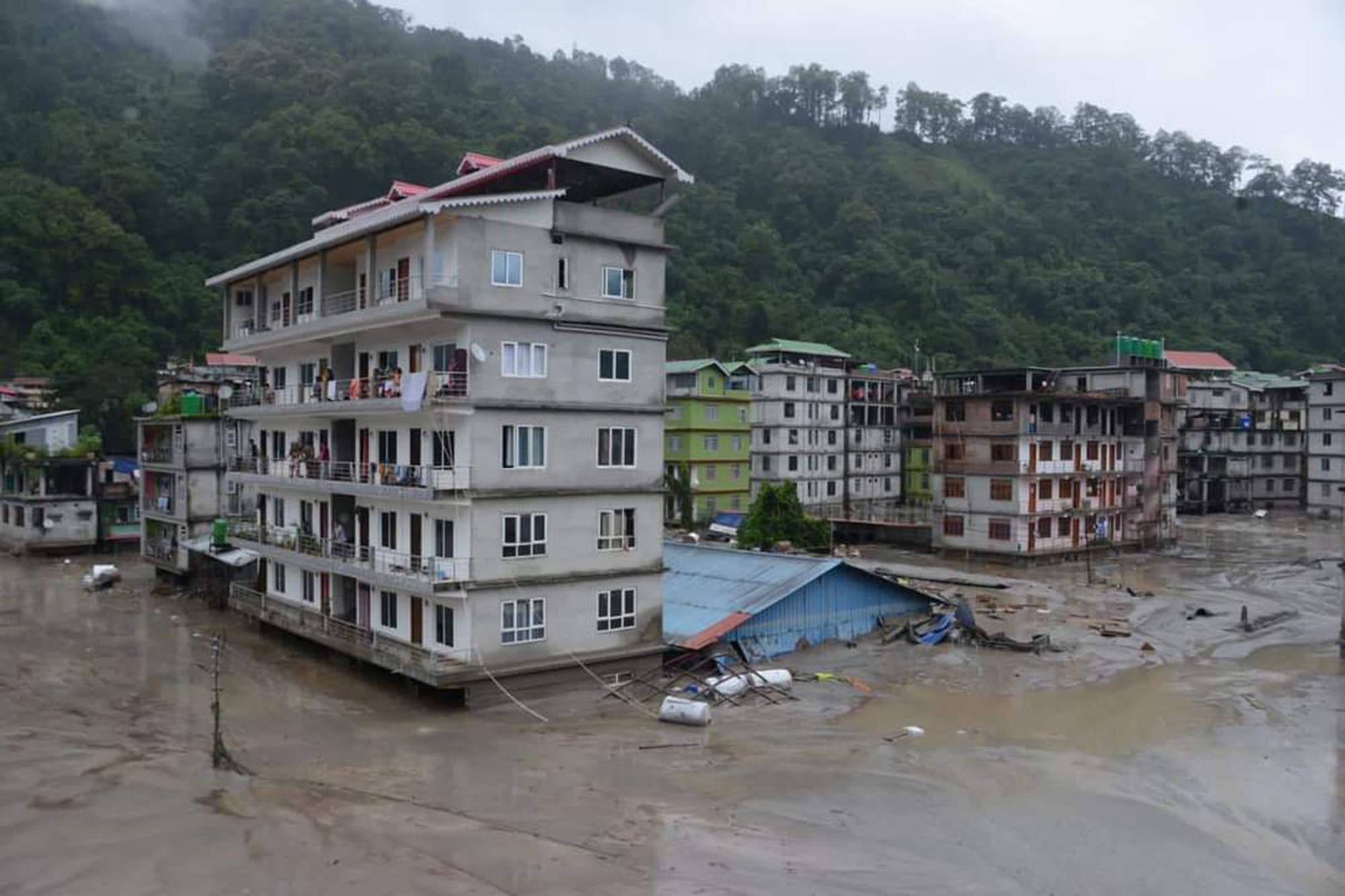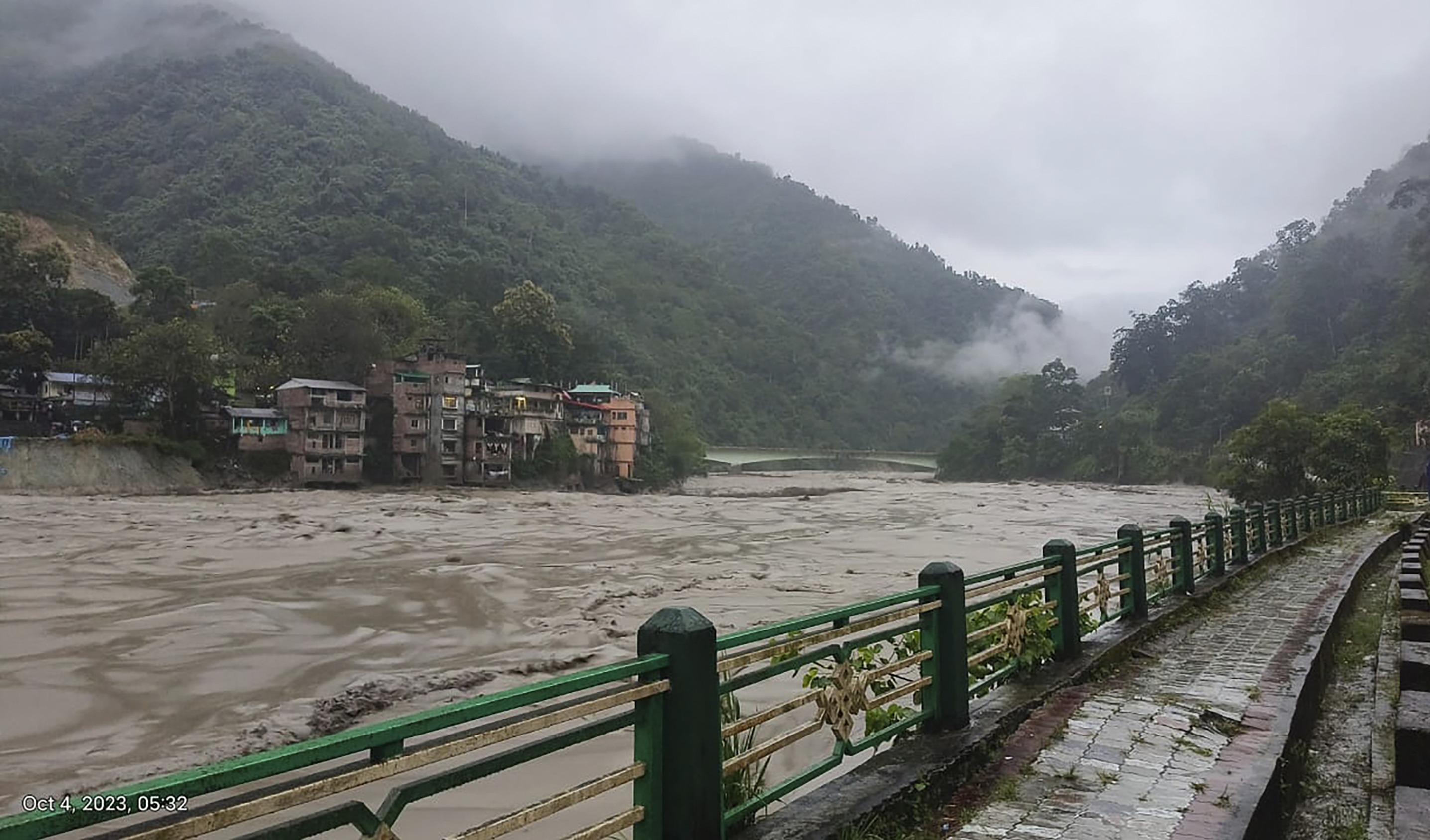 Buildings are inundated after flash floods triggered by a sudden heavy rainfall swamped the Rangpo town in Sikkim, India Oct 5, 2023. The flooding took place along the Teesta River in the Lachen Valley of the north-eastern state, and was worsened when parts of a dam were washed away. (PHOTO / AP)
Buildings are inundated after flash floods triggered by a sudden heavy rainfall swamped the Rangpo town in Sikkim, India Oct 5, 2023. The flooding took place along the Teesta River in the Lachen Valley of the north-eastern state, and was worsened when parts of a dam were washed away. (PHOTO / AP)
NEW DELHI/KOLKATA - At least 18 people were killed and nearly 100 were missing on Thursday after heavy rains caused a Himalayan glacial lake in northeast India to burst its banks, the worst such disaster in the region in more than 50 years.
Lhonak Lake in Sikkim state overflowed on Wednesday, causing major flooding that authorities said had impacted the lives of 22,000 people. It is the latest deadly weather event in South Asia's mountains being blamed on climate change.
The weather department said Sikkim received 101 mm (4 inches) of rain in the first five days of October, more than double normal levels, unleashing floods worse than one in October 1968 in which an estimated 1,000 people were killed
The weather department said Sikkim received 101 mm (4 inches) of rain in the first five days of October, more than double normal levels, unleashing floods worse than one in October 1968 in which an estimated 1,000 people were killed.
The department has predicted heavy rain over the next three days in parts of Sikkim and neighboring states.
The latest flooding was exacerbated by water released from state-run NHPC's Teesta V dam, local officials said. Four of the dam's gates had been washed away and it was not clear why they had not been opened in time, a government source told Reuters.
As of Thursday evening, 98 people were missing, 17 of whom were army personnel, state chief secretary VB Pathak told Reuters by phone.
READ MORE: India's monsoon rains hit five-year low due to El Nino
Fourteen bridges had been washed away, hampering rescue operations already affected by heavy rainfall. Pathak said 18 relief camps had been opened on Thursday where food and medical assistance was being provided.
Authorities in neighboring Bangladesh were on alert. A state-run water development board official warned that five districts in the northern part of the country could be inundated with a rise in the level of the Teesta river, which enters Bangladesh downstream of Sikkim.
Tourists stranded
Prabhakar Rai, director of Sikkim's State Disaster Management Authority, said bad weather was hampering rescue operations and described the situation as "slightly grim".
"Due to bad weather conditions we cannot have air service towards the northern part of the state," Rai told Reuters.
"Roads have been damaged at various places so communication is a big problem. Telephone communication disruption is also a problem in the upper reaches," he said. Silt that had collected in houses along the river bed was also slowing rescue work.
About 2,500 tourists are stuck in and around Chungthang town in Mangan district, about 100 km (60 miles) north of the state capital Gangtok, but they are in safe places and will be evacuated by air when the weather improves, Rai said.
An advisory from the state tourism department asked visitors planning trips to the scenic state to postpone travel and said those stuck in Mangan district would be evacuated from Friday subject to weather.
"All tourists stranded at Lachung and Lachen areas are safe and nothing adverse has so far been reported," the advisory said, referring to the two rivers that join to form the Teesta in Chungthang.
 Water levels of the Teesta river rises in Sikkim, India, Oct 4, 2023. Twenty-three Indian army soldiers are missing after a cloudburst triggered flash floods in the northeastern state of Sikkim. The flooding occurred along the Teesta River in Lachen valley, a statement from India's army said Wednesday, adding that search efforts were underway. (INDIAN ARMY VIA AP)
Water levels of the Teesta river rises in Sikkim, India, Oct 4, 2023. Twenty-three Indian army soldiers are missing after a cloudburst triggered flash floods in the northeastern state of Sikkim. The flooding occurred along the Teesta River in Lachen valley, a statement from India's army said Wednesday, adding that search efforts were underway. (INDIAN ARMY VIA AP)
Video footage from the ANI news agency, in which Reuters has a minority stake, showed flood waters surging into built-up areas where several houses collapsed. Army bases and other facilities were damaged and vehicles submerged.
Reuters photos showed earth movers and rescue workers shoveling silt and mud to dig out military vehicles buried by the riverside.
Satellite imagery showed that nearly two-third of the lake seems to have been drained.
Fuel scarce, food available
Sikkim, a small Buddhist state of about 650,000 people, was cut off from Siliguri in the neighboring state of West Bengal as the main highway had collapsed.
State lawmaker G.T. Dhungel told Reuters that petrol and diesel had become scarce in the state capital Gangtok but food was readily available.
A cloudburst on Wednesday dropped a huge amount of rain over a short period on Lhonak Lake, about 150 km (90 miles) north of Gangtok, triggering flash floods down the Teesta valley.
READ MORE: 21 killed, several feared missing as landslides hit northern India
Runoff from melting glaciers often pools in shallow lakes, held back by rocks and debris. The risk comes when a lake overfills, bursting through its natural barrier and sending a torrent of water rushing down mountain valleys.
A 2020 report by India's National Disaster Management Agency said glacial lakes are growing and pose a potentially large risk to downstream infrastructure and life as glaciers in the Himalayas are melting due to climate change.
The Indian Himalayas have witnessed torrential rains in the past few years that have set off deadly landslides and flash floods, killing more than 500 people this year alone and damaging critical infrastructure, with scientists increasingly blaming global warming as a key factor.


